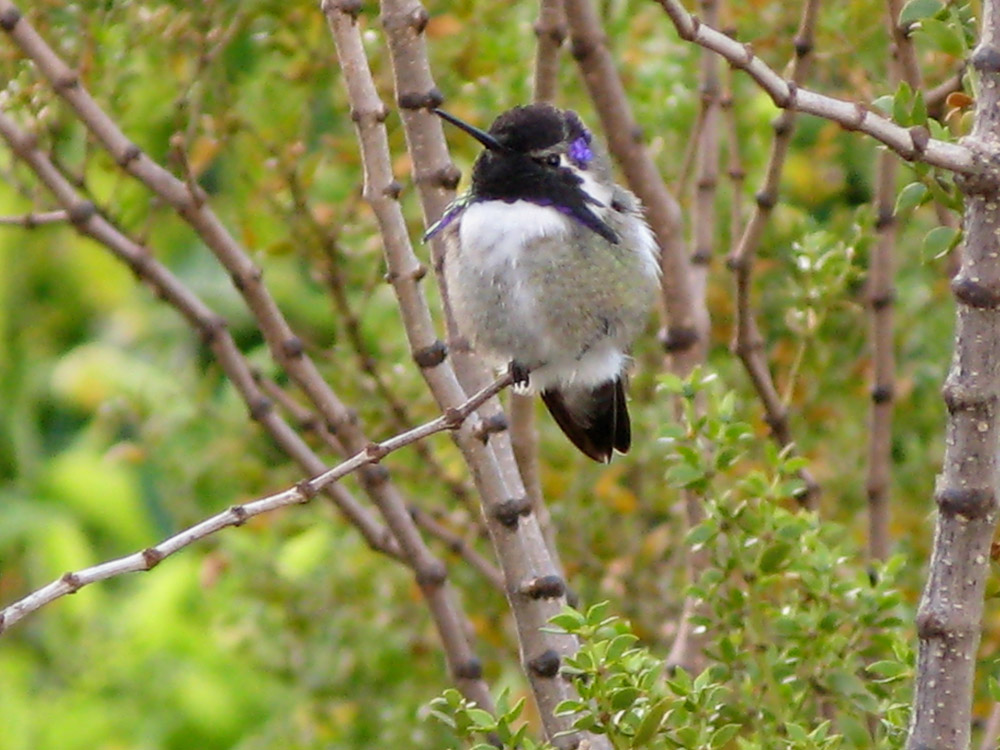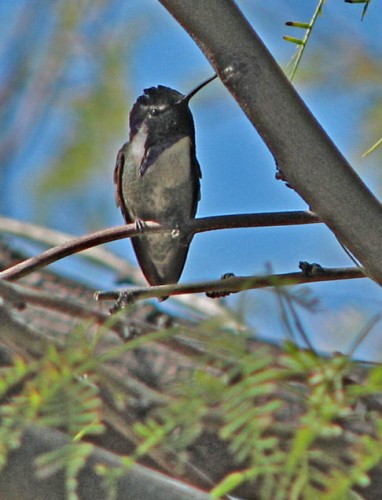Lousy with Costa’s
When the Gophersnake made its appearance, I was about to post on Costa’s hummingbirds, because “informal censusing” (= what we see in the yard) indicates that this is the season when the Costa’s hummer population is highest in our Phoenix area yard: we are lousy with Costa’s right now.
population is highest in our Phoenix area yard: we are lousy with Costa’s right now.
I would guess it has something to do with post-breeding population movement, and the fact that there are a lot of YOY (young of the year) out and about. Right now, at least three of our back yard nectar feeders are being defended by male Costa’s, one of which is an immature bird, still showing just a few purple spangles at the corners of its throat.
These tiny feisty birds definitely fall into the “dinky desert dude” category. They spend a lot of time in exciting high-speed tail chases, pursuing each other and other larger hummers like Anna’s away from the nectar sources, even in the impressive heat we’ve been experiencing. In between, they sip intermittently at nectar sources both natural and human-made, using the energy-rich fluid to fuel their aerial gnatting forays which provide them with protein.
 For now, the males seem to have quit their flight displays until next breeding season. But from their favorite perches — often on twigs under the canopies of open trees like palo verde and mesquite — they engage in quiet “singing” which is a descending sibillance so high and thin that some people can’t hear it. Even if it’s beyond your pitch range, you can always tell if a Costa’s is singing, because it “assumes the position”: a bit hunched, throat very slightly puffed, head forward and oscillating back and forth gently as the notes are emitted, as if to spray the sound evenly in all directions like audible air freshener, so other hummers in the area can hear it.
For now, the males seem to have quit their flight displays until next breeding season. But from their favorite perches — often on twigs under the canopies of open trees like palo verde and mesquite — they engage in quiet “singing” which is a descending sibillance so high and thin that some people can’t hear it. Even if it’s beyond your pitch range, you can always tell if a Costa’s is singing, because it “assumes the position”: a bit hunched, throat very slightly puffed, head forward and oscillating back and forth gently as the notes are emitted, as if to spray the sound evenly in all directions like audible air freshener, so other hummers in the area can hear it.
The top photo shows the typical neckless, puff-ball silhouette of a Costa’s, short-tailed and gray vested. In this light, the blazing purple of the “Yosemite Sam” mustachioed gorget is not activated, except for a patch behind the eye. Even without the bright color, the bird is easily identified by the pattern of dark and light, as in the photo on the left, with the white throat and neck contrasting strongly against the dark moustaches.
(Photos: top, Costa’s in yard creosote, A.Shock; bottom, Costa’s in Boyce Thompson mesquite, E.Shock)

[…] post-breeding influx of Costa’s hummingbirds in our Phoenix-area yard continues. This tough little desert hummer is present at the feeders […]